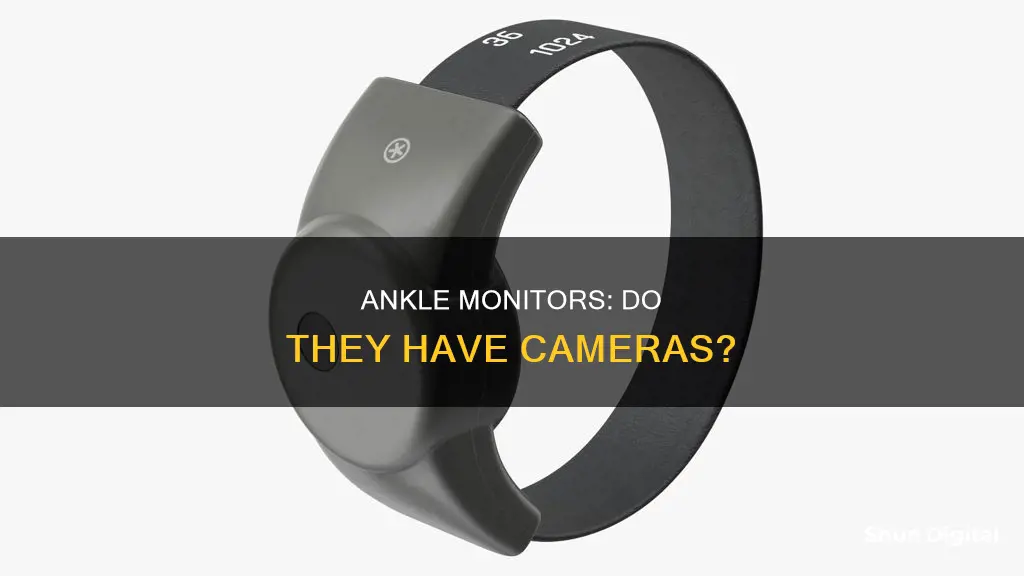
Ankle monitors are a form of surveillance used to track the movements of individuals who have been placed under house arrest, or who are on parole or probation. They are typically worn by defendants awaiting trial who are considered a danger to the community or a flight risk, or by those who have been convicted of a crime and received a supervised release into the community instead of a jail sentence. The monitors work by transmitting the location of the wearer via GPS, or by using radio frequency technology for short-range monitoring. This allows law enforcement to ensure the wearer is complying with their court orders, such as sticking to a specific area or maintaining a required distance from a victim. While ankle monitors can track a wearer's location and detect alcohol consumption, they do not have built-in cameras.
| Characteristics | Values |
|---|---|
| Do ankle monitors have cameras? | No |
| Purpose | To ensure the wearer doesn't get into more trouble, to make sure they don't flee, and to serve as an alternative to jail sentences |
| Who wears them? | Defendants who have been sentenced to house arrest, those on parole or probation, undocumented immigrants, and repeat offenders of drinking-related crimes |
| How do they work? | Ankle monitors log information about the wearer's location and transmit that information to a monitoring centre |
| Types | SCRAM (Secure Continuous Remote Alcohol Monitoring), RF (Radio Frequency), and GPS |
| How far can the wearer go? | This depends on the technology of the system; some allow for about 50 feet, while others allow for 100-150 feet |
| Are they waterproof? | Some are 100% waterproof, while others are only water-resistant |
| Are they uncomfortable? | They can be bulky and heavy, and wearers often struggle to get used to sleeping with them |
| Are they effective? | They are effective at tracking the location of individuals, but not necessarily at preventing them from committing crimes |
| Do they malfunction? | Yes |
| Do they have microphones? | Some do, some don't |
What You'll Learn

Ankle monitors do not have cameras
Ankle monitors are electronic devices fitted to an individual's lower leg, above the ankle. They are also referred to as ankle bracelets or ankle tags. The monitor works by transmitting the location of the wearer via GPS, allowing law enforcement to track their movements and ensure they are complying with court orders.
In addition to location tracking, ankle monitors can also be used to monitor alcohol consumption for repeat offenders of drinking-related crimes. These devices can measure blood-alcohol content through the wearer's skin or provide remote breathalyser testing. This information is then transmitted to the relevant authorities, including the wearer's probation officer.
While ankle monitors do not have cameras, some do have microphones built-in. However, the purpose of the microphone is to facilitate communication with the wearer, and there are laws in some states that limit law enforcement from using these microphones for other purposes.
The use of ankle monitors has been criticised for several reasons. One criticism is the lack of secondary checks on the information collected, leading to concerns about incorrect data and the potential for longer prison sentences or false accusations. Another issue is the lack of clarity around data ownership, as it is often collected by third-party companies and shared with multiple law enforcement agencies.
Despite these criticisms, ankle monitors have been shown to be effective in deterring crime and reducing reoffending rates. They also provide individuals with the opportunity to continue their regular lives while awaiting further court directions or completing alternative sentences.
Monitoring Home Water Usage: Smart Metering Solutions
You may want to see also

They are a form of surveillance
Ankle monitors are a form of surveillance. They are electronic devices fitted to an individual and worn around the ankle. They are also referred to as ankle bracelets or ankle tags.
Ankle monitors are used to track the movements of individuals who have been sentenced to restricted travel or activities. They are often used as an alternative to prison or jail time, allowing the wearer to continue with some semblance of their regular life while awaiting further court direction.
The device works by transmitting the location of the wearer via GPS or radio frequency technology. This allows law enforcement to track the individual and ensure they are complying with their court orders, such as house arrest or parole conditions.
In addition to location tracking, ankle monitors can also be used to monitor alcohol consumption for repeat offenders of drinking-related crimes. These devices can measure blood alcohol content through the wearer's skin or provide remote breathalyzer testing.
Ankle monitors are often used as a form of bail or probation, with the goal of deterring repeat offences and providing an alternative to incarceration. They can also be used in immigration contexts to track undocumented immigrants facing removal from a country.
While ankle monitors do not currently have cameras, they do raise privacy concerns due to the amount of information they collect and the potential for future advancements to include additional monitoring capabilities.
Asus Monitors: Are There Built-In Microphones?
You may want to see also

They are used as an alternative to prison sentences
Ankle monitors are increasingly being used as an alternative to prison sentences. They are typically used for individuals who are on probation or parole, or those awaiting trial. They can also be used for people convicted of a crime but who are considered low-risk and not a danger to the community.
Ankle monitors are a form of surveillance, allowing law enforcement to track the movements and locations of individuals. They are often used to ensure that a person is complying with the terms of their sentence, such as maintaining sobriety or adhering to restricted travel. The monitor works by transmitting the location of the wearer via GPS, and an alarm is triggered if it is removed.
One advantage of ankle monitors is that they are less expensive than traditional imprisonment, and they allow individuals to maintain their jobs, support their families, and reintegrate into society more easily. However, there are also disadvantages. Ankle monitors can be uncomfortable and cause skin irritation, and wearers are subject to strict rules and regulations, with any violation resulting in additional penalties or imprisonment.
While ankle monitors provide an alternative to incarceration, critics argue that they are another form of incarceration themselves, with restrictive rules and constant surveillance. Additionally, there are financial implications, as most individuals are required to pay for the cost of the monitor, which can be a significant burden, especially for those who cannot afford it.
In conclusion, while ankle monitors offer a viable alternative to traditional imprisonment in certain cases, they also present challenges and concerns regarding civil liberties, financial burden, and the effectiveness of rehabilitation.
Adobe RGB vs sRGB: Which Monitor Should You Buy?
You may want to see also

They are used to monitor sobriety
Ankle monitors are used to monitor sobriety. These devices are known as Secure Continuous Remote Alcohol Monitors (SCRAM) and they can detect alcohol in a person's sweat. They sample the wearer's perspiration every 30 minutes, providing 24/7 transdermal alcohol testing. This helps to ensure compliance with court-ordered sobriety and can be used as an alternative to prison sentences for those with substance abuse issues.
The SCRAM bracelet is a lightweight, waterproof device that is worn around the ankle. It provides accountability and encourages compliance, supporting long-term behaviour change and complementing treatment for alcohol dependence or addiction. By automatically testing the wearer's sweat, the SCRAM bracelet eliminates testing gaps and increases community safety. It also distinguishes drinking from environmental alcohol sources, providing courts with confidence in the test results.
The use of SCRAM bracelets has become popular in some states and countries as a diversion from prison or jail time, especially for first-time and non-violent offenders. For example, in Washington State, thousands of residents were using SCRAM bracelets as part of an alternative sentence in 2013. Similarly, in England, "sobriety tags" started being rolled out for some offenders who commit alcohol-related crimes in 2021.
The cost of an ankle monitor for alcohol monitoring is typically covered by the wearer, with installation fees ranging from $50 to $100 and daily monitoring fees ranging from $10 to $15. This can add up to a monthly cost of up to $300. Despite the cost, ankle monitors are still a more affordable option than incarceration, which can cost over $20,000 per year.
Unboxing Your ASUS Monitor: A Step-by-Step Guide
You may want to see also

They are used in immigration cases
Ankle monitors are used in immigration cases to track undocumented immigrants who may be facing removal from the United States. They are also used as an alternative to detention for immigrants seeking asylum.
Congress established the program in 2002, and the use of GPS monitors increased in 2014 when thousands of unaccompanied minors and families fled to the US-Mexico border to escape gang and drug violence, as well as domestic violence in Central America.
Immigrants with ankle monitors are required to stay within 70 miles of their home and are usually not allowed to cross state lines. If the monitor's battery dies or the wearer ventures outside of their assigned area, alarms are triggered.
Immigrant advocates and legal experts argue that ankle monitors are inappropriate and inhumane for people seeking asylum. They have been referred to as "a modern-day scarlet letter" and "electronic shackles". Immigrants have reported experiencing emotional, mental, and physical distress due to the monitors, including trouble sleeping, mental health issues, migraines, depression, and thoughts of suicide.
Monitoring Web History on Your ASUS Router
You may want to see also
Frequently asked questions
No, ankle monitors do not have built-in cameras.
An ankle monitor is a device that tracks and records the location of the wearer and sends this information to a monitoring centre.
Ankle monitors are usually shaped like a close-fitting bracelet and are worn around the lower leg, above the ankle. They are often waterproof and lightweight. The monitor communicates with an on-site receiver, which is generally located in the residence of the wearer. The wearer must stay within a specific distance of the on-site receiver for the bracelet to work. The on-site receiver then sends the information about the location of the bracelet to an off-site receiver for humans to review.
There are three types of ankle monitors commonly used in the justice system: SCRAM (Secure Continuous Remote Alcohol Monitoring), RF (Radio Frequency), and GPS.
Ankle monitors are used as an alternative to prison or jail time. They are often used for defendants who have been sentenced to house arrest or those who are on parole or probation. Ankle monitors are also used in healthcare settings and in immigration contexts.







